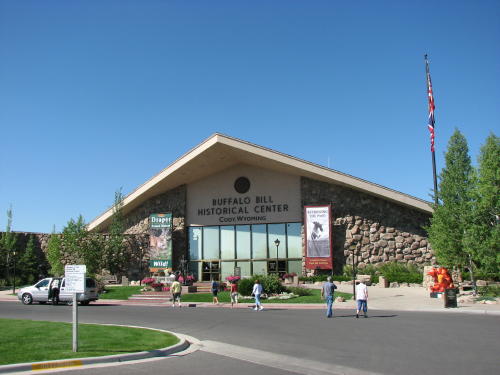
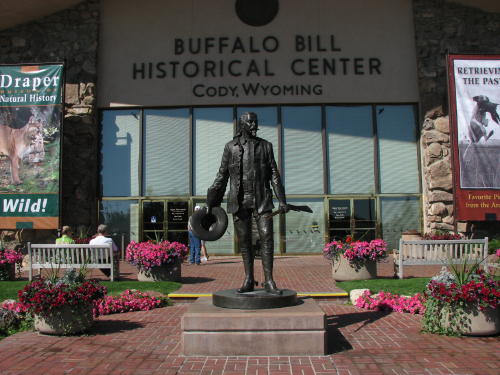
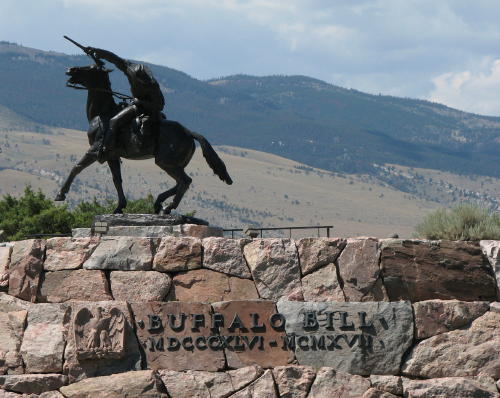
Buffalo Bill Historical Center - 2008 . . .
on our
route to the Pacific Northwest
Updated: 11/30/08
The Buffalo Bill Historical Center is on Cody, Wyoming.



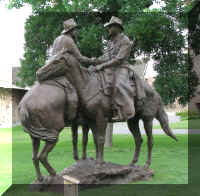 Walking
from the RV parking lot, you pass this bronze of two cowboys shaking
hands. Many deals were settled with a handshake.
Walking
from the RV parking lot, you pass this bronze of two cowboys shaking
hands. Many deals were settled with a handshake.
Point of information . . .The RV parking lot is behind the
building which has no rear entrance. If someone in your party has difficulty
walking, drop them off at the front door prior to parking.
The Code of the West
The center is organized into five sections (museums) - Buffalo Bill Museum, Plains Indian Museum, Whitney Gallery of Western Art, Cody Firearms Museum and the Draper Museum of Natural History. The McCracken Research Library is also housed in this facility.
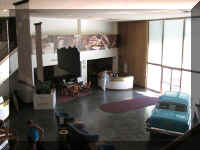
Some art pieces were displayed in the balcony - wheels of buffalos rotating continuously and a horse by an artist known to make her pieces out of 'junk'. This horse is made from drift wood.
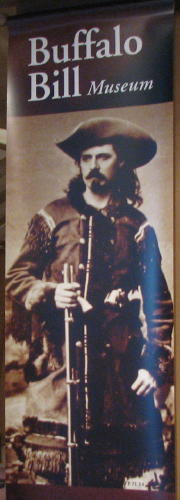 Our
fist visit was to the Buffalo Bill Museum.
Our
fist visit was to the Buffalo Bill Museum.
As we walked through the museum, we discovered that William F. "Buffalo Bill" Cody was quite an entrepreneur.
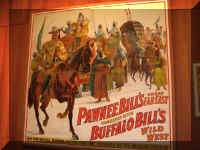
He opened the Irma hotel in Cody to serve people coming to Yellowstone National Park on the train. The hotel was named after his daughter.
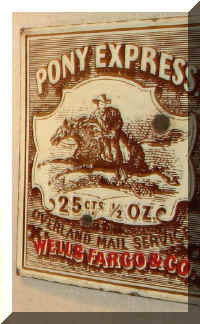 One
display included a pony express saddle that was unique to us.
One
display included a pony express saddle that was unique to us.
The mail service fee was rather steep - 25 cents for a half an ounce.
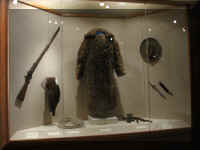
This coat is made from Russian furs.
The revolver has hand engraved ivory grips.
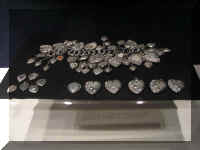
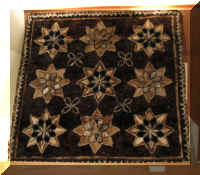 This
blanket was a gift to Wild Bill, the star design is created using various animal
pelts found in Russia.
This
blanket was a gift to Wild Bill, the star design is created using various animal
pelts found in Russia.
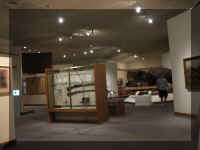
Fred remembers watching Wild Bill Hickok on TV.
The real guy doesn't look like the TV hero.
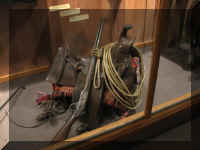
Some items on display were not period pieces. One example is this 1996 foosball table.
In this era they did not have recreational vehicles - not much free time available. But, this sure looks like the start of an the RV industry. This one was used as housing for a sheep herder until 1950.
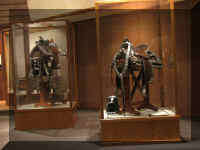
One saddle was available for kids of all ages to try out.
The buffalo - or - the American Bison . . .
A chuck wagon was on display.
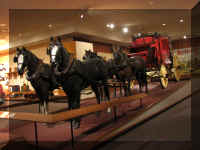
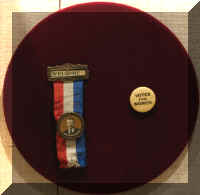 Bill
Cody was know for his support of women. His wife was also an entrepreneur keeping her
business ventures in her name because Bill's would sometimes succeed, sometimes
go bust.
Bill
Cody was know for his support of women. His wife was also an entrepreneur keeping her
business ventures in her name because Bill's would sometimes succeed, sometimes
go bust.
As he got older he gave up horseback as a way of transportation for a buggy. The items that look like Christmas tree glass ornaments are actually targets for shotgun practice. Today, people use clay "pigeons".
He was a Mason. A fraternity to which many of our founding fathers belonged. Masonic members continue to do good works for people today.
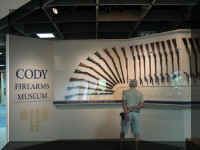
There were 1,500 firearms on the main level and another 1,200 on a lower level. Some types we had never seen before.
One collector donated guns from TV and movies. Guns from Ponderosa and Annie Oakley, to name a couple.
Wheellocks . . .
Blunderbuss . . .
Pistols with > > > Two hammers and one barrel - Two hammers and two barrels - One hammer two barrels.
Revolver rifle and a revolver pistol . . .
A windlass crossbow . . .
A rifle with a cartridge catching bag . . .
A water cooled machine gun . . .
Every collection has to have a Gatling gun . . .
A cartridge loading machine was on display.
This BB gun in the middle is like the one Fred used as a child. He shot many a toy soldier standing in a cardboard box in his parent's basement.
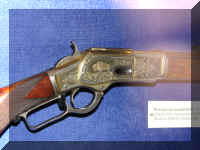
As we walked through the Embellished Arms Gallery, a guy told us his rifle was just put on display the week before. He proudly pointed out his rifle and posed for a photograph.
The Whitney Gallery of Western Art was very nice. It is a collection of paintings and bronze sculptures that is outstanding.
Beautiful paintings . . .
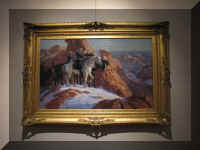
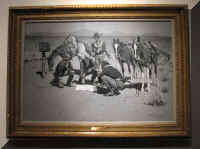 This
black and white had exquisite detail.
This
black and white had exquisite detail.
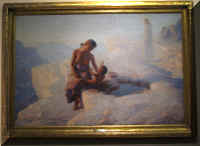
Motherhood
Notice figure in top right corner of painting
Bead art . . .
Some exhibits displayed a sculpture from which the artist created the painting or vise versa.
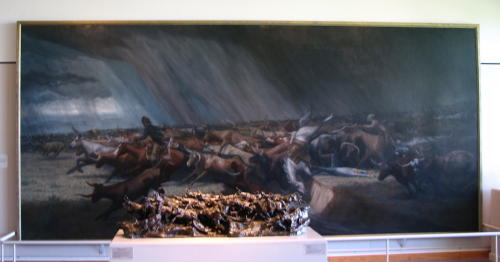
They had a big display of Frederic Remington's work, including a recreation of his studio.
This sculpture of a cowboy giving his horse water actually had water dripping . . .
Painted sculpture of a stampede . . .
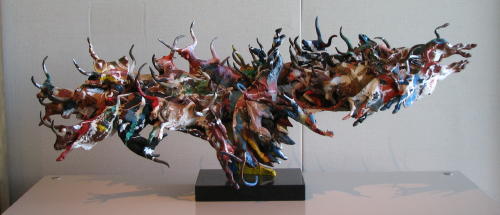
Our second visit to the museum was to see the childhood home of Buffalo Bill and the Plains Indian Museum. We should have allowed more time for the Plains Indian Museum.
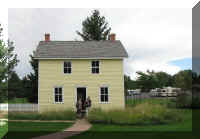 Buffalo Bill's childhood home was located outside between the Buffalo Bill
and Plains Indian museums. It is under development. There wasn't much to see
inside. There were photographs of the house along the Mississippi during the
period of Bill's childhood.
Buffalo Bill's childhood home was located outside between the Buffalo Bill
and Plains Indian museums. It is under development. There wasn't much to see
inside. There were photographs of the house along the Mississippi during the
period of Bill's childhood.
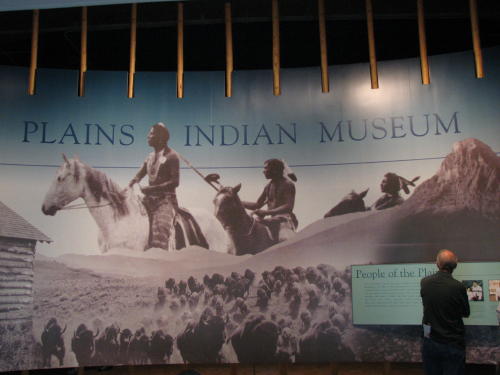
Clothing, both women and children's decorated with moose teeth demonstrated how successful the husband was in hunting.
Exhibits of native apparel were frequent.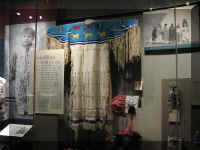
Tipi . . .
Several exhibits included painted animal hides.
Originally, dogs carried the packs as the families moved from place to place. Once horses were introduced, many Indian families traveled in this manner.
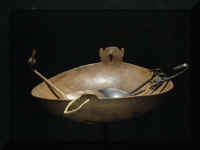
This headdress is beautiful.
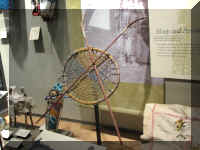
A round room created like the inside of a woman's lodge was used for a video presentation of the women's role in the plains Indian culture.
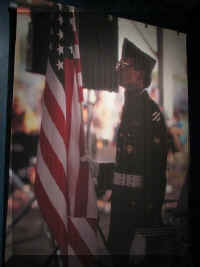
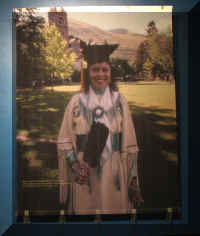 The Native Americans are very proud of the tribe members
who are successful in
the armed forced and pursuits of educational goals.
The Native Americans are very proud of the tribe members
who are successful in
the armed forced and pursuits of educational goals.
The government eventually expected Indians to moved into houses.
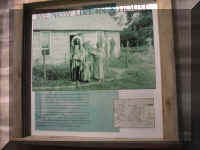
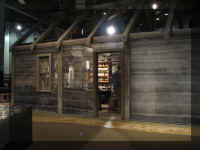
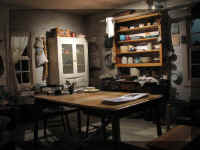
Did you notice that the exhibit permits you to look through the wall of the
house?
Peace metals were given to the Indian chiefs when treaties were signed.
A wide screen video of what life was like for the Plains Indians during the four seasons of the year.
This bear was located outside the building. There were many in Cody. They are being auctioned for charity after the tourist season.
The Buffalo Bill Historical Center offered a lot of history in the various museums under one roof. Admission was $15 (seniors $13) and included the day of purchase and the following day. They offered no discounts. We spent a total of about six hours but did not look at the natural history portion.
GO BACK TO > > > Pacific Northwest - 2008